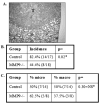Matrix metalloproteinase-9 from bone marrow-derived cells contributes to survival but not growth of tumor cells in the lung microenvironment
- PMID: 16397239
- PMCID: PMC1360653
- DOI: 10.1158/0008-5472.CAN-05-2502
Matrix metalloproteinase-9 from bone marrow-derived cells contributes to survival but not growth of tumor cells in the lung microenvironment
Abstract
The role of specific stromal-derived matrix metalloproteinases (MMPs) was analyzed in experimental metastasis assays in wild-type and either MMP-9, MMP-7, or MMP-2 null mice. MMP-9 null mice showed an 81% reduction in Lewis lung carcinoma tumor number, whereas MMP-7 null mice showed a 42% increase in tumor number, and there was no difference in tumor number in MMP-2 null mice compared with wild-type controls. Similarly, in an orthotopic model of lung cancer, 50% fewer MMP-9 null mice were able to establish tumors in the lung compared with control mice, although the size of the tumors was not different. The effect of MMP-9 on lung tumor colonization was dependent on the expression of MMP-9 from bone marrow-derived cells and is most likely contributed by neutrophils. To examine temporal effects of stromal MMP-9, bioluminescence imaging from luciferase-expressing human lung cancer-derived A549 cells revealed that there were fewer tumor cells in the lungs of MMP-9 null mice as early as 19 hours after injection compared with control mice, with no difference in subsequent growth rates. Six hours after injection of tumor cells, MMP-9 null mice showed a 4-fold increase in the percent of tumor cells undergoing apoptosis compared with control mice. We conclude that MMP-9 from the bone marrow contributes to the early survival and establishment of tumors in the lung and has no effect on subsequent growth. These results provide insights into the failure of MMP inhibitors in clinical trials in patients with late-stage lung cancer.
Figures






References
-
- Fidler IJ. The organ microenvironment and cancer metastasis. Differentiation. 2002;70:498–505. - PubMed
-
- Egeblad M, Werb Z. New functions for the matrix metalloproteinases in cancer progression. Nat Rev Cancer. 2002;2:161–74. - PubMed
-
- Stamenkovic I. Matrix Metalloproteinases in tumor invasion and metastasis. Seminars in Cancer Biology. 2000;10:415–33. - PubMed
-
- Lynch CC, Matrisian LM. Matrix metalloproteinases in tumor-host cell communication. Differentiation. 2002;70:561–73. - PubMed
-
- DeClerk YA. Interactions between tumour cells and stromal cells and proteolytic modification of the extracellular matrix by metalloproteases in cancer. Eur J Cancer. 2000;36:1258–68. - PubMed
Publication types
MeSH terms
Substances
Grants and funding
LinkOut - more resources
Full Text Sources
Other Literature Sources
Medical
Molecular Biology Databases
Miscellaneous

